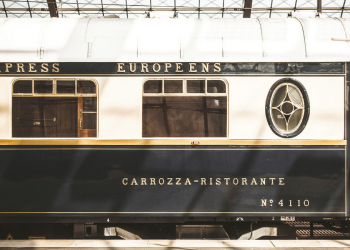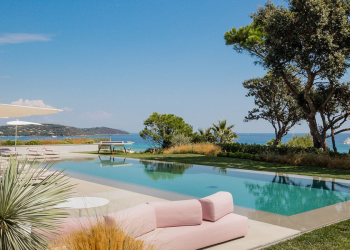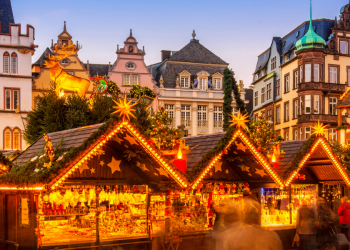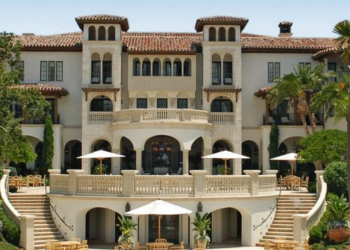By Luke Barr, Bob Guccione, Jr., Jim Greer, Camilla Paul, Reggie Nadelson
They’re the iconic classics. Time hasn’t stood still but hasn’t drastically changed them either.
All great hotels are built on a fantasy—the suspension of mundane, day-to-day reality—one that envelops you as soon as you walk in the door. At some level, the fantasy is about wealth: check in, and a team of servants materializes. Someone to carry your bags, someone to take care of your dinner reservations, someone to make your bed in the morning…. Press a button on your room phone and ask for anything in the world to be brought to you immediately—french fries, an electric toenail clipper, a live armadillo–and someone will try their best to deliver it. All of this deluxe servitude is about more than comfort however; it is also a kind of theater, a play in which your role is that of the oligarch, the aristocrat, the incognito celebrity, someone who commands attention, someone who rules the world.
It should come as no surprise that the grandest of hotels, the icons of Old World hospitality, were born in the Belle Époque and the Edwardian era, the late 19th and early 20s centuries, a time of vast decadence and wealth, of colonialism and empire, of ocean liners and Orient Express trains, and the beginnings of travel as a form of luxury. These hotels are steeped in history–time capsules of opulence and unapologetic formality. Today, of course, they offer wifi connections and flat-panel TVs, but the original ethos continues, stronger than ever, in spite of the modern trend of sometimes sterile, dispassionate hospitality, the exaltation of design and style over substance. The Old World discretion and hospitality embodied in these hotels is rarer than ever in the modern world, which makes them all the more remarkable.
By no means a complete list, here are a few of our favorite hotels of the grand style, true classics, which preserve their original mandate of discrete and refined to an art form hospitality.
The Ritz, Paris
Opened on the Place Vendome in 1898 by Cesar Ritz, the original luxury hotel impresario, with a restaurant overseen by Auguste Escoffier, the celebrated chef. The Ritz has been the epitome of Parisian glamour ever since: Coco Chanel lived in a suite on the second floor for decades; Ernest Hemingway was a regular at the bar. (“When I dream of afterlife in heaven,” he wrote, “the action always takes place in the Paris Ritz.”) The hotel re-opened in 2016 after a 4-year, $225 million renovations. www.ritzparis.com
Raffles, Singapore
On one level, Raffles should only exist in movies — a living, breathing facsimile of 19th century British Colonialism, complete with Sheiks-only doormen, magnificent warrior figures who would literally eat the metrosexual doorman half-heartedly attending a trendy modern hotel. The pace is immutably slow — and worth crossing the planet just for that — the gleaming white stone architecture and vibrant green, tropical landscaping bursting in color and brightness and an improbable unsulliedness. It’s not just the property but the period that is preserved intact.
The historic Long Bar, where the Singapore Sling was created (or not, according to dispute over its blurry origins, but who cares? This is the place to drink it!) still sits becalmed and harlequinned in cooling, subtly-lit elegance and sun pouring through the high windows. One imagines it hardly changing since Rudyard Kipling, the Poet Laureate of British Colonialism, or Mark Twain, the restless father of modern American literature, drank there (and one or other famously wrote the food is great, but the beds suck. I’m paraphrasing. And the beds are great now.)
But here it is, in the modern, interconnected world, surrounded by stalagmites of office and residential skyscrapers which would have been as frightening as dinosaurs had Kipling and Twain seen them. And it’s currently undergoing a renovation that will continue for the next few years, including a respectful restoration of the Long Bar and several of the restaurants and its bakery. So maybe the ghosts of Kipling and Twain — and Somerset Maugham, and Joseph Conrad, who got there when it opened, when he was still a seaman, are finally being shooed off the premises….
Modernization hasn’t dimmed the charm of Raffles since the end of the 1800s and a bit of renovation won’t do it either. While the work is going on, parts of the hotel will be closed, but the remainder will be open, until they close completely at the end of this year, with a scheduled reopening in mid 2018. www.raffles.com/singapore
Kulm, St. Moritz
The Kulm Hotel in St Moritz is one of the true grand hotels of the world, not just because of its magnificent size, or its 160 plus years of continuous existence, or its stained-through glamour — and without necessarily even being the grandest hotel in St Moritz. There is just something divinely beautiful and special about it. From a sprout of a nondescript 12 room pensione in 1855, it has evolved into a virtual town unto itself, with 132 rooms and 40 suites, six restaurants and four bars and, duh, a park. The hotel’s majestic sunshine yellow and cream facade sits serenely and imperially on a wide plateau in the Swiss Alps.
The Kulm was the first hotel in St Moritz. (It was also the first to have electric light in all of Switzerland, in its dining room for Christmas 1879). And the concept of winter sport vacationing was born here, when, at the end of the summer season in 1864, sitting around the fireplace with four of his English guests, owner and founder of the now quite elegant hotel, Johannes Badrutt, asked them why they didn’t also come in winter? Winters in the snowy pillows of St Moritz were warm and bright during the day, and crisp at night, and one could ski some of the most beautiful slopes in the world. “Paradise on Earth” he called it. The English were not sold on this, their experience of winter being, well, English. So Badrutt made them what has become known as The Bet: come for Christmas, see if you like it, and if not he would reimburse them their travel costs and rooms. They took him up on it, stayed till Easter, and the rest, as they say, is marketing history. That’s when rich people knew how to live!
“Travelers don’t stay in hotels as long as they did in the past. Our past travelers stayed up to 3 months in our hotel, today the average length of stay has shrinked to four nights in winter and three nights in summer,” says Heinz Hunkeler, General Manager of the hotel. “Choosing a hotel now depends a lot on making a ‘good deal’ rather than the emotional bond to the hotel. At the Kulm, as soon as a guest contacts the hotel, there will be one dedicated person in the reservations department to help them organize their stay.”
When I suggest that so often even top hotels lack personality or a distinct charm, he replies: “Travelers are experiencing state-of-the-art infrastructures in some of the most modern hotels worldwide today — infrastructure but not emotions.”
So how important is discretion in a world that has abandoned the notion of privacy?
“It is crucial,” Heinz says. “We can’t guarantee discretion, when someone is posting images about their stay on Instagram. But our teams would not share any information about guests to anyone, doing as much as we can to secure their privacy.” www.kulm.com
Grand Hôtel du Cap-Ferrat
Sure, the French Riviera sounds like a dream, now. But back in 1908 when a coachman by the name of M. Péretmère bought six and a half hectares of land from King Leopold II of Belgium, he was taking a flyer on what was then an isolated wilderness of rocks and scrubland. It was nobody’s idea of heaven. But Péretmère persevered, and built his hotel, which passed through a few undistinguished owners until 1922, when two professional hoteliers, Messrs.’ Henri Dehouve and André Voyenne, took over the hotel and transformed it into the “Palace de France” for which it has since become renowned — earning that latter distinction from the French government itself in 1911.
Illustrious guests over the years have included Somerset Maugham, Charlie Chaplin, Winston Churchill and Aristotle Onassis. Picasso took swimming lessons there, as did the children of Paul McCartney and Frank Sinatra, though presumably not all at the same time.
In 2007 the hotel undertook an expansion, and now features a whopping 74 rooms, including 24 suites and a penthouse, and three world-class restaurants. Of particular interest to those among you who a) drink wine and b) are obscenely rich, the wine cellar at Cap-Ferrat boasts a collection that includes 140 bottles of Château d’Yquem dating from 1854, and 38 bottles of Château Lafite Rothschild dating from 1799. For those keeping score at home, 1799 was the year Napoleon took control of France, ending the French revolution. Whether or not that momentous event is detectable in the wine of that vintage no one except the Chinese billionaire who buys that bottle will ever know. www.fourseasons.com/capferrat
The Beverly Hills Hotel
“Swimming pools, movie stars….” Rarely has the theme song to a mildly diverting TV show from the 1960s (Beverly Hillbillies, in case you’re younger than 75) so pithily summed up the feature attractions of one of our country’s most glamorous cities and hotels. The Beverly Hills Hotel opened in 1912, and the Pink Palace — as no one but the hotel’s own website calls it — immediately attracted movie moguls and silent film-era celebrities (Mary Pickford, Douglas Fairbanks, Buster Keaton), who also remained silent while staying at the hotel (of course they didn’t, just kidding!).
It even has a period that hotel aficionados call “The Glamor Years,” which extended from the 1930s to the 1970s, when everyone from Fred Astaire to Elizabeth Taylor to Marilyn Monroe to Howard Hughes holed up behind its stucco walls. The Rat Pack took over the hotel’s famous Polo Lounge beginning in the 1950s, when, in that Hollywood ordained way, it was the top place to eat and drink in LA, and maybe the country. Even now Frank Sinatra’s ghost has been rumored to pick fights with unlucky patrons, especially Tony Bennett. If you’ve never been, you’ve still seen the exterior of the hotel: it’s the one featured on the Eagles’ unlistenable masterpiece Hotel California. (To clear up nothing, the Beverly Hills Hotel is apparently not the inspiration for song/album.)
In recent years the hotel suffered through something of a boycott by some high-profile celebrities, protesting Sharia Law in current owner Sultan of Brunie’s country. That storm seems to have passed, and the hotel, which does not practice Sharia Law in any way, deservedly remains an icon. After an extensive and, one later realizes, needed, renovation between 1993 and 1995, the hotel reopened brightly refreshed and refurbished, and gloriously still idiosyncratic and much the same.
Given its history of star clientele, absolute discretion has been paramount. But the hotel has always lived in a paradox, a place that offered coveted secrecy but where it was also important, when not having an affair of course, to be seen. And for decades before cellphones, the ultimate Hollywood status symbol was to be paged in the bar of the Polo Lounge. Patrons seeking to look important would tip the hotel’s ultimately very famous bellhop, who was also a midget and colloquially known as “the Philip Morris Man”, after the actor in the old radio cigarette ads, to walk through the bar and dining room calling out their name, summonsing them to a phone call that didn’t exist. www.dorchestercollection.com
Claridge’s, London
The name Claridge’s brings to mind grace, style, elegance. Located in the exclusive district of Mayfair, it began life as a hotel at 51 Brook Street, in the early 1800s, in a house owned by William and Marianne Claridge. In 1854 the couple bought five adjoined buildings and Claridge’s the hotel was opened in 1856. It quickly became favoured by royalty and other of the loftier folk wandering this great Earth. In the 1920’s it was the place to party and in 1929 new rooms, a gorgeous ballroom and the glorious art deco lobby were added, cementing Claridge’s art deco heritage. During the Second World War it became home and haven for several branches of European royalty. In the 1950s Claridge’s became the go-to London hotel for visiting Hollywood stars. Spencer Tracy stated he would rather go to Claridge’s than heaven, an opinion he possibly revisited upon death.
The Queen Mother used to regularly dine here. It’s that sort of place. Her favourite table always had sweet peas on them. The Royals are like that: down to earth — sweet peas as common an English culinary adornment as you can get — yet inexorably Royal. http://www.claridges.co.uk
D’Angleterre, Copenhagen
There is a tendency to think of Denmark as awfully “Hygge,” a word that expresses what has become a fashionably cozy style—knitted hats, pot bellied stoves, mulled wine, a currently fashionable style which means, most of all, cozy. But in the d’Angleterre, Copenhagen’s very grand hotel is an altogether different and very stately style.
This is a city that has always mattered, and the hotel, which overlooks Kongens Nytorv, the central square, dates back to 1755. It has grand columns, glittering chandeliers, a restaurant with a Michelin star, and some of the most impeccable service in Europe.
The rooms have been beautiful and lavishly redone. But it’s the history that make the d’Angleterre great; its position as host to a hundred royal balls and weddings, and to Amundsen’s return from the South Pole in 1912 give it a panache almost nothing in Scandanavia matches. www.dangleterre.com
The Taj Mahal Palace, Mumbai
The 2008 attacks on the Taj Hotel in Mumbai hit at the very heart of India’s most cosmopolitan, diverse, tolerant city. It came back better than ever, but, then, it had to. This is the last of the great city palace hotels that have an essential place in a particular location, a particular culture.
It is rare that one hotel has the status of an absolutely essential landmark these days, but the Taj does. Inside the enormous hotel is a world of shops, bars, restaurants, a gorgeous pool, beauty salons, the best pedicure I’ve ever had. You can live at the Taj for the rest of your life, and many Indians have done so. Those who grew up in Mumbai talk of bringing their laundry to be done at the Taj or meeting a fiancé at tea. The rooms and the suites, especially in the originally wing are straight out of a fairy tale. The service means your butler will tuck you in—literally, if you like.
The lavish exterior is all domes and cupolas. It overlooks the Arabian Sea and the Gateway to India, where Lord Mountbatten tipped his hat as he — and the British Empire — left the country forever. In a sense, the Taj was a response to all the prejudice of the Empire. Indians were often refused rooms at Europe’s grand hotels, and India built one much much grander. www.taj.tajhotels.com
The Mandarin Oriental, Bangkok
Kings and Tsars, Posh and Becks, Burton and Taylor have all famously stayed at the Mandarin Oriental. It’s a fabulous hotel, the restaurants stunningly good, the terrace overlooking the Chao Praya River wonderfully evocative, the service unbelievable; my underwear was returned from the laundry exquisitely folded in pale lavender tissue, the box arrayed with tiny orchids.
But what gives the Oriental its real punch are the literary connections it makes so much of. Somerset Maugham, who apparently visited almost every grand hotel on earth, describes it in The Gentleman in the Parlour; Graham Greene, William Golding, James Michener, Joseph Conrad and Noel Coward adored it. And so the Author’s Wing. This is the original part of the hotel where the suites are named for writers, and you fall asleep imagining you might someday be one of them. www.mandarinoriental.com
For more articles like this, check out our friends at Wonderlust Travel.







